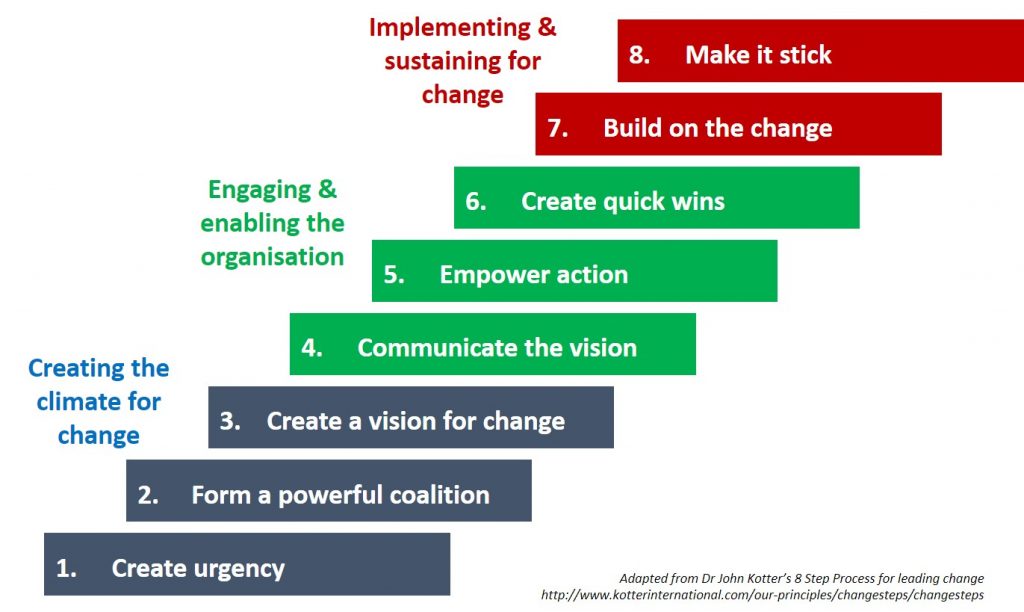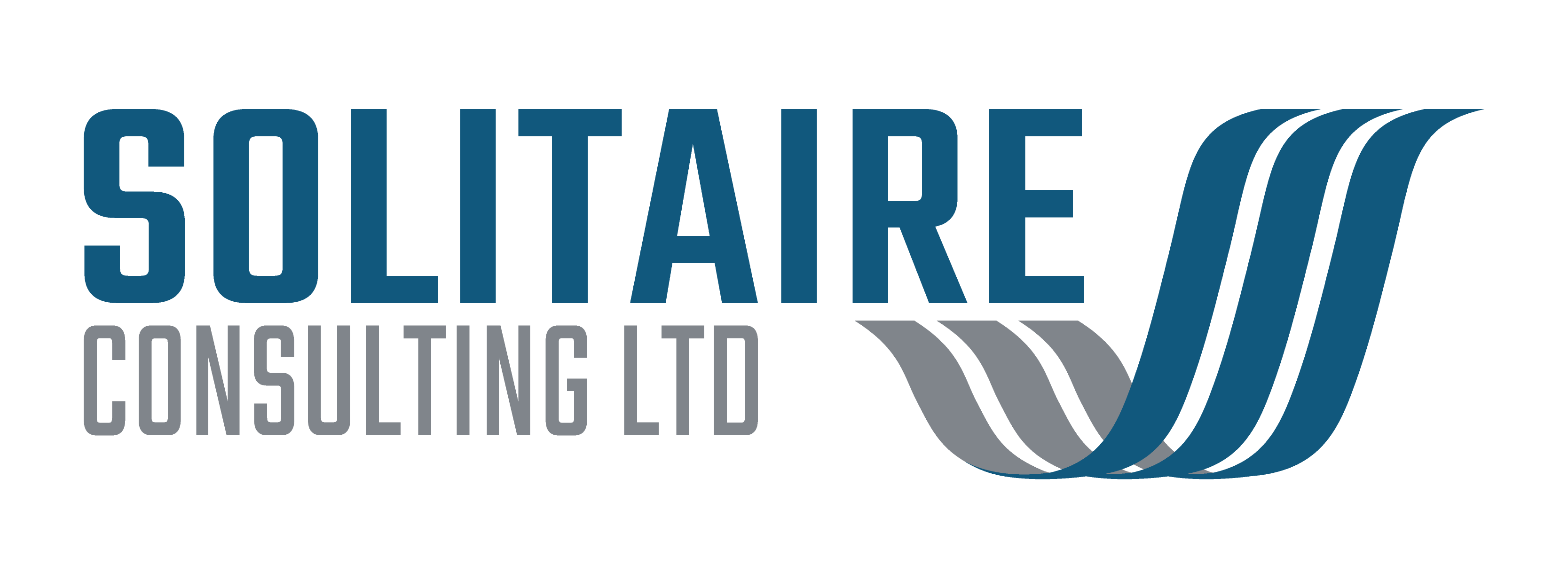Kotter’s 8 Step process for leading change is perhaps the most widely known model for tackling change in an easy step-by-step approach. It is also the tool we use when implementing new technology systems or to support a digital transformation process. I will not go into the model in great detail because there are plenty of online resources available including from Dr Kotter’s site. However, I will describe how we use the model at Solitaire Consulting and what we think is good and bad about it.
The model is based on 8 steps, which I’ve shown below sequentially. However, in reality some of the steps are often carried out in parallel, or even repeated, through the lifecycle of the change project.

The 8-step process for leading change
1. Create Urgency
- Examine the market and competitive realities
- Identify and discuss crises, potential crises or major opportunities
When managing change it is helpful to have some sense of urgency which helps to answer the question ‘Why now?’. In the projects we manage this could be due to regulation, the competitive environment, or the ending of support for an existing system (the so-called “Burning Platform”). If there isn’t a sense of urgency then one should be created!
2. Form a powerful coalition
- Assemble a group with enough power to lead the change effort
- Encourage the group to work as a team
This is a critical element of lasting change and one that is often missing from projects when we get involved. There is a need for senior stakeholders to work together towards a common goal.
3. Create the vision for change
- Create a vision to help direct the change effort
- Develop strategies for achieving that vision
The Project Plan needs to be turned into a compelling case for change with clear objectives in the short, medium and longer term.
4. Communicate the vision
- Use a range of methods to communicate the vision and strategies
- Demonstrate new behaviours and ways of working by the example of the Project Team
A mixture of face-to-face briefings, one-on-one meetings, emails, intranet etc. will be used to reinforce the key messages. A communications plan will provide the detail and act as a management tool for monitoring progress.
5. Empower broad based action
- Remove obstacles to change
- Change systems or structures that undermine the vision
- Encourage risk-taking and non-traditional ideas, activities and actions
During the implementation of changes, support needs to be provided at all levels to ensure tasks remain on track and correcting action is taken as early as possible.
6. Create quick wins
- Plan for visible performance improvements
- Implement these improvements
- Recognise and reward employees involved in these early improvements
The project plan will be focused on delivering some early wins. These will not necessarily create the greatest step-change to achieve the vision but will need to change behaviours and attitudes to change.
7. Build on the chage
- Hire, develop and promote employees who can implement the vision
- Reinvigorate the process with new projects, ideas and actions
Regular reviews should be undertaken to look for opportunities to learn from and build on previous successes.
8. Make it stick
- Articulate the connections between the new behaviours and the organisation’s success
- Develop the means to ensure leadership development and succession
Lasting change will only come after changes have been successfully implemented, but the means to achieve change on a continuous basis needs building into individual’s roles.
What is good about this
We all like simple step-by-step instructions and just like a recipe it promised a perfect result provided you have all the ingredients, the right environment, the right utensils and the right people. It is well understood by many and therefore creates a common language with lots of people able and willing to offer input and advice.
What is bad about this
It is simplistic and formulaic and each step is more easily said than done. How many ways can each step be interpreted and implemented? The truth is that organisations are as different and varied as the people in them. Whilst the model can help us make generalisations about change, they don’t actually help us deliver the change. This is a bit like understanding the shape of a house, but that doesn’t make us either an architect or a builder.
Our experience
A lot of management consultants will hand out simple books like “Our Iceberg Is Melting: Changing and Succeeding Under Any Conditions” as if to say “Look it’s easy.” But beware the do-it-yourself approach to change. It may be appealing, but some things (like riding a bicycle or playing the violin) are best learned by experience rather than reading a book. As Red Adair once said “If you think its expensive hiring a professional, try using an amateur”
However the advantage of the model, and the book, is that it is a conversation starter. It gets people thinking, and whilst the best approach for any organisation will depend upon context and resources, the model does help people understand some of the key elements of change, and that it is a process that needs to be orchestrated, even if in reality it is not as simple and sequential as the model suggests.
I have mentioned the book Our Iceberg Is Melting: Changing and Succeeding Under Any Conditions because it is a cheap hand-out to senior managers and staff and a great primer for the journey ahead. I do not believe for one moment that change happens in such a formulaic way but like all models it is not about whether it is true, it is about whether it is useful.
If you are interested in this or any of the other tools, techniques, training or models for change please get in touch. We offer advice, coaching or consultancy which may be useful to support technical or organisational change. We are happy to have a coffee (virtual or physical!) and a conversation about your needs and possible approaches without any obligation. We love what we do and are happy to share that with you.





